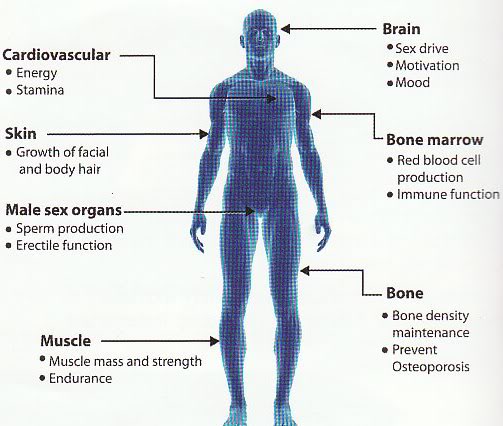All hormones in the human body have individual uses and functions that are imperative to form a healthy human being, however some can be considered more important and versatile that others. Testosterone is one of these, although not unique to men it is one of the most prominent hormones in the male genetic make-up. Testosterone is the principal male sex hormone and is primarily responsible for the development and maintenance of male sex characteristics e.g.
- Voice deepening
- Bodily and facial hair growth
- Development and grown of the male sexual organs
- Increase in libido and sexual function
- Increased sebum secretion of the skin.
These uses alone show it to be a hugely important hormone in the male body, however it has a multitude of other uses and functions that make it anincredibly versatile and necessary hormone.
How does it work?
Here comes the science bit. Hormones do their jobs by binding to receptors either just outside or within a cell and telling them what to do to complete a necessary task.
Testosterone itself is steroidal in nature, this means that it only binds to androgen receptors and it does so by entering the cell membrane. Not all hormones have the ability to do this, however because of the steroidal nature of testosterone it can easily pass through the outside fatty (phospholipid bilayer) layer of the cell membrane. Once Testosterone binds to an androgen receptor, both the hormone and the receptor together form a receptor complex. This complex travels to the nucleus of the designated cell where it will activate specific DNA sequences. These sequences are called the hormone response element because they are specific to the purpose of testosterone???s effects on the cell.
What does it do in the body?
Essentially testosterone is an anabolic, this means that it promotes muscle growth through its ability to signal protein synthesis increase. So, when the hormone response element for muscle cells is activated, gene transcription begins. This means that the specific code of DNA is copied and read, and can then be used to instruct the cell to increase the synthesis and construction of proteins that will elevate muscle strength and size. Testosterone also specifically targets certain alternative tissues in the body.
- Sub-dermal and dermal tissue
- The scalp
Kidneys
Bone
- The central nervous system
- Prostate
These tissues are all androgen responsive, and the interaction with all of these is what brings on the male sex characteristics experienced during puberty, as well as increasing muscle growth, stimulating red blood cell development and in turn increasing lung capacity.
What problems does low testosterone cause?
The amount of testosterone each man produces varies depending on certain demographic characteristic such as genetics, age, lifestyle habits, activity levels and nutritional habits. However, there is a median range which is considered healthy, but this median range has its own breakdown of low, middle and high. Because of this it can be difficult for doctors to diagnose low testosterone level. Research has indicated that may be many men suffering from the effects of low testosterone. The initial symptoms tend to present as, reduction in sexual function and libido, a loss of energy, decline in strength and physical performance, as well as depression, decreased motivation, memory loss and muscle loss. And if all this isn???t bad enough low testosterone levels have also been associated with a risk of cardiovascular disease.
Testosterone treatment
Luckily, treating low testosterone is relatively easy and since the synthesis of testosterone in the 1930's into anabolic steroids it has been hailed as an almost miracle drug. It has been used to treat an impressive variety of illnesses including, female breast cancer, muscle wasting diseases such as HIV, muscular atrophy, osteoporosis, and male infertility. As well as treating pre diagnosed illnesses, using anabolic steroids to restore testosterone to the median amount has been shown to reduce the amount of fat tissue in the midsection and improve the body's sensitivity to insulin. These results can be extremely useful in preventing health complications such as diabetes and cardiovascular disease.
Non-medical uses of testosterone
The use of steroids in a non-medical sense is frowned upon in most parts of the world, this is due the stigma of athletes using these as performance enhancers to cheat in professional competitions. However, using anabolic steroids for the reason of enhancing performance and physique remains the number one commercial use of the product. But, contrary to popular opinion, the main users are not high flying sports men but in fact just regular guys. The average user is actually reported to be a middle-class man of 25-35 years who wants to use the product for purely personal improvement purposes. Also, the common misconception is that steroids are used a fast track pass to the perfect body, however this isn't the full truth in most cases. For men who have reached their genetically allowed limit in terms of much muscle mass they can add, testosterone can allow them to surpass this limit, and this is often the main point of using performance enhancers like anabolic steroids steroids.


No comments:
Post a Comment
Note: Only a member of this blog may post a comment.